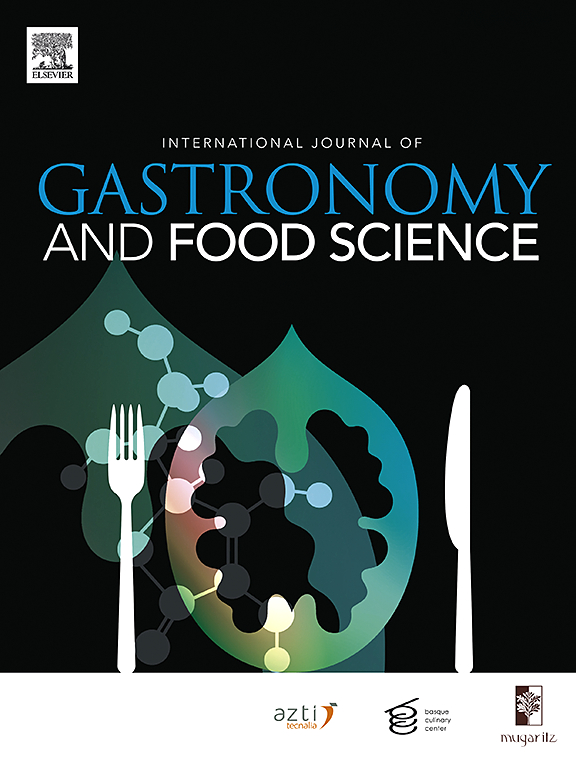Sour bamboo shoots in Guangxi: A study on microbial diversity and differentiation of flavor characteristics in different fermentation methods
IF 3.6
2区 农林科学
Q2 FOOD SCIENCE & TECHNOLOGY
International Journal of Gastronomy and Food Science
Pub Date : 2025-09-01
DOI:10.1016/j.ijgfs.2025.101282
引用次数: 0
Abstract
This study investigates the flavor profile and microbial communities of home-fermented and factory-fermented sour bamboo shoots from Liuzhou, Guangxi, using HPLC, HS-SPME-GC-MS, and Illumina MiSeq sequencing. The pH levels were similar between both fermentation types. A total of 46 volatile flavor compounds were identified, including alcohols, phenols, ethers, acids, esters, and aldehydes. Key distinguishing compounds the fermentation methods were p-cresol, 4-ethyl-2-methoxyphenol, and acetic acid, with significant differences between home- and factory-fermented samples.Notably, home-fermented samples contained significantly higher levels of p-cresol (85 ± 15 μg/L vs 12 ± 3 μg/L in FSS), 4-ethyl-2-methoxyphenol (detectable only in HSS), and acetic acid (1.2 ± 0.2 g/L vs 2.8 ± 0.3 g/L in FSS; all p < 0.05).Microbial analysis revealed that Lactobacillus was the dominant genus in both types of fermentation, but its abundance was higher in home-fermented samples. Additionally, Sphingomonas and Deinococcus were more abundant in home fermentation. Organic acids such as HPS and PGS were also found in higher concentrations in home-fermented sour bamboo shoots.
The study indicates that home fermentation yields a richer microbial community, more complex flavor substances, and higher concentrations of organic acids compared to factory fermentation. These results enhance our understanding of how fermentation methods influence the quality of sour bamboo shoots, providing a basis for further research on microorganisms role in flavor development and offering insights for the innovation of local fermented products.
广西酸笋:不同发酵方式下微生物多样性及风味特征的差异研究
本研究采用HPLC、HS-SPME-GC-MS和Illumina MiSeq测序技术,对广西柳州自制酸笋和工厂酸笋的风味特征和微生物群落进行了研究。两种发酵类型的pH值相似。共鉴定出46种挥发性风味化合物,包括醇类、酚类、醚类、酸类、酯类和醛类。对甲酚、4-乙基-2-甲氧基酚和乙酸是发酵方法的关键区分成分,在家庭发酵和工厂发酵样品之间存在显著差异。值得注意的是,自制发酵样品中对甲酚(85±15 μg/L, FSS中为12±3 μg/L)、4-乙基-2-甲氧基酚(仅在HSS中检测到)和乙酸(1.2±0.2 g/L, FSS中为2.8±0.3 g/L,均为p <; 0.05)的含量显著较高。微生物分析结果表明,乳酸菌在两种发酵类型中均为优势菌属,但其丰度在自制发酵样品中较高。此外,鞘单胞菌和Deinococcus在国内发酵中含量较高。在自制酸笋中也发现了HPS和PGS等有机酸的较高浓度。研究表明,与工厂发酵相比,家庭发酵产生更丰富的微生物群落,更复杂的风味物质和更高浓度的有机酸。这些结果增强了我们对发酵方式对酸笋品质影响的认识,为进一步研究微生物在风味形成中的作用提供了基础,并为当地发酵产品的创新提供了见解。
本文章由计算机程序翻译,如有差异,请以英文原文为准。
求助全文
约1分钟内获得全文
求助全文
来源期刊

International Journal of Gastronomy and Food Science
Social Sciences-Cultural Studies
CiteScore
5.30
自引率
10.50%
发文量
170
审稿时长
45 days
期刊介绍:
International Journal of Gastronomy and Food Science is a peer-reviewed journal that explicitly focuses on the interface of food science and gastronomy. Articles focusing only on food science will not be considered. This journal equally encourages both scientists and chefs to publish original scientific papers, review articles and original culinary works. We seek articles with clear evidence of this interaction. From a scientific perspective, this publication aims to become the home for research from the whole community of food science and gastronomy.
IJGFS explores all aspects related to the growing field of the interaction of gastronomy and food science, in areas such as food chemistry, food technology and culinary techniques, food microbiology, genetics, sensory science, neuroscience, psychology, culinary concepts, culinary trends, and gastronomic experience (all the elements that contribute to the appreciation and enjoyment of the meal. Also relevant is research on science-based educational programs in gastronomy, anthropology, gastronomic history and food sociology. All these areas of knowledge are crucial to gastronomy, as they contribute to a better understanding of this broad term and its practical implications for science and society.
 求助内容:
求助内容: 应助结果提醒方式:
应助结果提醒方式:


